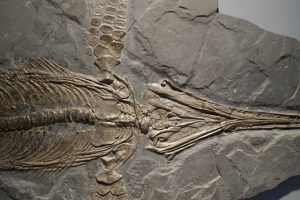In April 2022 University of Zurich scientists went public about an extraordinary discovery. They had uncovered several 205-million-year-old fossils, the remains of giant oceanic creatures known as Ichthyosaurs. These remarkably intact fossils, however, did not emerge from strata deep below the surface but from a site 2,700 meters above sea level in the Swiss Alps. One of them is shown in the image below. It had grown to an estimated length of 20 meters and would have weighed some 80 tons. It has been described as ‘the largest animal that ever lived.’
Fossils at 2,700 meters makes you stop and think. It’s only natural to wonder about what caused them to be there in the first place. We’re far more used to archaeologists digging deep below the present-day surface in their search for fragments of past life. Within our fragmentary, occluded, everyday existence we know the world as it currently appears – a familiar assembly of landscapes and features that change very slowly, if at all. In some distant, abstract corner of our minds we also know that in the past everything was different. But, aside from a few specialists, we tend not to think about the vast disruptions, upheavals and aeons of erosion that sculpted the foundations of the world and continue to do so.
Shifts of perspective can de-familiarise things and illuminate the world in unexpected ways. In this case the discovery provided fresh impetus for the ‘deep dive’ into the Earth’s distant past that had preoccupied me for a while. The following short article is the first product of these efforts. It’s a work in progress that outlines some of the issues, as I see them, for the practice of Futures Studies and Applied Foresight in these troubled times. It appeared in the May 2022 issue of Compass, the on-line journal of the Association of Professional Futurists. I’m grateful that the piece was made available so that it could be re-presented here in this form. Read article…

